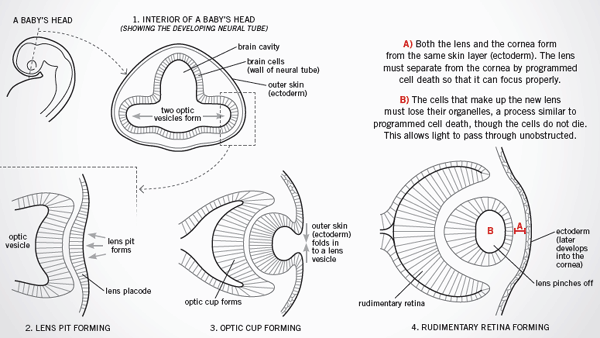
Death by Design
If our genes and cells arose randomly through competition for supremacy, then how can we explain so many wonderful processes where cells are programmed to sacrifice themselves for the good of the whole, especially during development?
To date, science offers no real definition for life, but from our human experience, nothing defines life better than death. Yet drawing the line between life and death can get quite interesting. For instance, the mere absence of life is not death—after all, rocks are not “dead.”
The Gift of Life—From a Single Cell
Life is always a gift from one being to another, like an eternal flame that is passed along from one generation to the next. However feeble the flame may be, at least one is needed to light others, and they, in turn, light some more. And so it goes on; there is no spontaneous combustion. The over 7 billion life candles we see in the world today bear the flame that God first kindled in Adam and Eve some 6,000 years ago.
Among humans and many animals and plants, the continuity of life involves two gametes (or sex cells, namely sperm and an egg) coming together and forming a single fertilized egg. Remarkably this new cell in a human is so tiny that we can observe it only under a microscope. The wonder of this new life is even more staggering when we perceive that an “Ashley” or a “David,” a future singer or plumber or president, arises from that single cell.
This special cell divides over and over again, until it becomes the 100 trillion or so cells that characterize an adult human. The trillions of cells somehow come together at defined points to form beautiful symmetry with mind-boggling, nano-scale precision.
What if the two sides of the nose failed to meet midway? Instead of a puddle or scar face, what usually forms on every one of our faces is something that even the great master artists can only dream of capturing.
Both the unicellular zygote and the trillions of adult cells have life, but this life exists apart from the individual cells. During development, cells often “die,” but life remains.
The Necessity of “Cell Death” to Build Our Bodies
Many cells purposefully sacrifice themselves for the good of the body, a marvelous testimony to the Creator’s careful design.
Indeed, many cells must purposefully sacrifice themselves for the good of the whole body, a marvelous testimony to the Creator’s hand. For example, some serve as scaffolds, supporting the emergence of more permanent and specialized cells. In the wake of each new organ is a fast-disappearing trail of cells—cells that must “die” by design.1 This process is appropriately termed programmed cell death (PCD).
The clean-up and removal of the scaffolds is far from a random process. Thus a grand orchestration of cell death sculpts organs and organ systems; and as the baby grows to maturity, trillions of cells are lost, eliminated by this precisely controlled process. Amazingly, the immune system remains silent while the body gradually loses several persons worth of cells!
In an adult, when any one of these trillions of cells turns rogue, the self-destruct button in that cell is frantically triggered (the programmed cell death tool kit is present in all cells with nuclei). When the self-destruct machinery fails, just one rogue cell can—as a spreading cancer—threaten the life of the whole organism.
Note: PCD should not be confused with a better-known process called necrosis. Necrosis usually involves the uncontrolled demise of cells in response to external forces, such as heat or trauma. Necrosis is an ugly affair, characterized by the breakdown of the cell membrane, loss of energy, swollen organelles (tiny parts of the cell—like mitochondria), and the dumping of cell contents into the outside environment, thereby provoking the body’s immune response. The surrounding region may also suffer scarring.
The PCD machinery in cells can sometimes be hijacked by certain viruses and cancer cells. Some viruses and cancers halt programmed cell death so they can proliferate unchecked in the undying cell.
Other viruses, such as HIV, are harmful because they trigger programmed cell death in certain immune cells that normally fight off pathogens. In particular, they attack the white blood cells known as helper T cells, thereby compromising the body’s immune system and opening the body to numerous secondary infections.
Death Programs
Cells have several different ways to bring about their own demise, with fancy names such as apoptosis, autophagy, anoikis, and excitotoxity. The details are complicated, but an example or two will help illustrate their crucial role during development and adult life.
Our skin must constantly produce and replenish a tough layer of outer armor, made of “dead” skin cells (beauty is skin deep!). These cells die by producing a protein called keratin, which eventually chokes off the cell (keratin is the tough but flexible material in your fingernails and hair). This particular form of cell death is called cornification. Another example of programmed cell death is the removal of the webbing that exists between fingers during fetal life; and this process is called apoptosis.
Formation of the Eye
Let’s consider the role of programmed cell death in sculpting just one organ, the eye.2
Cell Death in Eye Formation

Click to enlarge
A young baby begins with a simple neural tube that eventually must produce many different organs like the eye. Programmed cell death plays a vital role in the eye’s formation.
The eye’s retinal cup (or optic cup) forms from a neural tube that extends out from the brain (Figures 1 & 3). Simultaneously a layer of skin (ectoderm) forms over the optic cup (Figure 2). By a marvelous process, the skin cells eventually differentiate into the outer cornea, which indents and forms the beginnings of a lens called a lens pit; at this point, the presumptive lens and cornea are still attached to each other. For the eye to become functional, two other crucial events must occur, both of which require cells to die or cell organelles to be cleared.
First, the lens must separate from the cornea so that it can freely change shape and focus sharp images. Early in a child’s development, programmed cell death selectively kills the tethering cells, detaching the lens from the cornea (Figure 4).
Second, the cells that make up the lens must lose their inner parts (organelles) so that light can freely pass through them. A programmed process clears away the organelles from inside the lens cells.
Failure to detach the lens from the cornea leads to abnormalities such as Peter’s anomaly; and if the organelles are not cleared, a cataract (clouding of the lens) can result. Thus during eye formation (as in other organs), cell life and cell death must work together harmoniously in order to achieve the miracle of vision.
The “Frangible Nuts of Life”
Whenever I see a space shuttle launch, the precise timing of events reminds me of the PCD process. After the space shuttle is rolled out to the launching pad, the solid rocket boosters are secured to the earth by eight pyrotechnic-controlled frangible nuts that prevent wind gusts from knocking the shuttle over.
When the launch sequence zeroes and the boosters roar to life, these nuts must blast apart in unison, freeing the shuttle from the pad and allowing it to fly. Incredibly fine-tuned technology goes into ensuring that the nuts are exploded at the right moment and simultaneously so as not to tilt the departing spacecraft. But according to a report, despite all the rigorous testing and standards of NASA, about 25 frangible nuts have failed in 23 launches.
In contrast to the high failure rate of manmade frangible nuts, the PCD process (the “frangible nuts of life” if you will) separates the lens from the cornea in half a million developing babies every day. And untold billions of other cells sacrifice themselves for the other organs to develop properly in each of those children.
The precise separation of the lens gives us clear vision to see God’s marvelous handiwork all around us (Psalm 19; Job 12:7–10), as well as the amazing space technology dreamed up by the creative creatures He made in His image. The biological processes that sculpt just one part of our body—our eyes—are so exquisitely and perfectly controlled that it beggars belief to insist that the “frangible nuts of life” were designed by a mindless, random process of evolution.
Just as cell life and cell death are important for maintaining the life of an organism, so the Bible tells us “that all things [yes, trials as well as joys] work together for good to those who love God, to those who are the called according to His purpose” (Romans 8:28).
Just as an organism has life beyond the death of a cell, so the life of the soul continues beyond bodily death. And just as the decision each cell makes to live or die decides the fate of the organism, the choice that we make in accepting or rejecting Christ determines our eternal life or death.
Choose wisely.
Answers Magazine
April – June 2011
Continual attacks on God’s Word can cause even Christians to question the Bible. Are you prepared to answer the attacks, or more important, questions from those who honestly want to learn how we know God’s Word is true? This issue of Answers will burrow down to the heart of the matter, highlighting seven reasons we know the Bible is true!
Browse Issue SubscribeFootnotes
- For a discussion of how the terms life and death are used in the Bible, in contrast to modern biology, see “The Mystery of Life” in Answers (July–September, 2008), pp. 60–62.
- The description of the eye’s development is based on the author’s doctoral research on the zebra fish eye, but biologists presume that this process applies to the eyes of humans all animals that use a camera-like eye with a lens.
Recommended Resources

Answers in Genesis is an apologetics ministry, dedicated to helping Christians defend their faith and proclaim the good news of Jesus Christ.
- Customer Service 800.778.3390
- © 2024 Answers in Genesis



